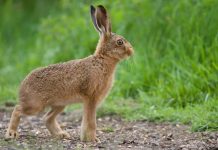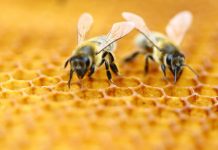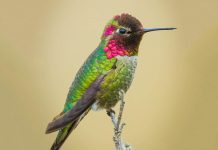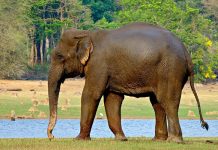The brown bear is the national animal of many states of North America, Europe and Asia. The most of the brown bears are found in the wooded and mountainous region of North America and Eurasia. This bear looks enormously gigantic. Its height ranges from 6—10ft which makes it largest specie of bear. The polar bear is the only sub specie of bear that can match the height of the brown bear. What makes the bear stand above other species and sub species of bear are its enormous size, hump on back and strong shoulder muscles. Brown bear can break the bones of any animals just in a single swipe. This makes it extremely dominant in the wild. This animal doesn’t possess threat from any other animals apart from humans. Human beings kill this animal mostly for taxidermy. Taxidermy is the process of filing, preserving and cleaning skin of dead animals with another animal’s skin to make it look as if they are alive. Presently only 200,000 bears are left in the world.
Brown Bear Characteristics
- The male brown bears are 6 to 9 feet long and female brown bears are 5 to 8 feet long
- The weight of the bear depends upon its location and kind of diet they’re eating. General weight of the brown bear is 400 to 1200 pounds
- The brown bear can live approximately 25 years in the wild
- The litter size of the bear is 1 to 4 cubs. Generally they give birth in pairs
- An offspring weighs around 1 to 1.5 pounds
- Brown bear gets mature till the age of 3 to 5 years
- The hibernation period depends upon their habitat. Generally they hibernate from October through March
- The brown bear prefers to live in solitary except at the mating period
- The major threat to their life is human being. Wolf and cougar also prey upon brown bear
- The cubs can climb tress to save themselves from predators. But an adult brow bear are too heavy to climb trees
- Although brown bear is not listed as endangered species but their habitat is under perpetual threat
- The brown bear can survive over half a year without eating, drinking, urinating or defecating
- This animal has four paws and each paw has 5 toes with long claws
- Brown bears are omnivorous animals. Their main prey is fish, fruit, insects
- The total number of teeth in brown bear’s mouth is 42 which also consist of predatory teeth to shed skin of its prey
- Brown bear do not bite their prey instead they grind and crunch
- The teeth of the bear increases in height with its teeth.
Brown Bear Facts For Kids
- All brown bears aren’t brown in color. Some are black or cream
- Brown bears dig craves where they sleep most of the winters
- Brown bears give birth to their baby in sleep. Baby brown bear drinks their mother milk and stay warm in their mother’s fur
- The hibernation period of brown bear lasts till 5 to 8 years. During their period of resting, their heart rate and temperature drops. They even stop excreting waste from their body
- Many people think that Brown bear is a farsighted animals. This is a myth; their eyesight is at par with humans. The sense of smell of brown bear is 100 times better than humans
- The baby of brown bear weighs less than human baby. Babies are born blind with no fur on their body
- They are the only predators in the animal world that eat both meat and plants
- Brown bear can run at the speed of 40 miles per hour.
Appearance
Brown bear is the second largest specie of bear after polar bear. Some are even as large as polar bears. The head of the bear is massive and round with well-developed blunt muzzle. Overall, this bear has a concave facial profile. The ears are set wide apart on head and are small in size. The brown bears have four paws with 5 toes each. Every toe has big claws which grows up to 15 cm long. Brown bears are excellent swimmers and can also stand on their hind legs. They have huge hump on their back and shoulders are broad as well as strong.
Size and Weight
The length of the animal is 2 - 3 m (6.5 - 9.75 ft.). The tail is 5 - 20 cm long. The weight of the brown bear is 100 and 1,000 kg. Males are 50% larger than female.
Coat and Color
The brown bear has a thick coat with mane on their neck. The longer guard hairs have white tip which give them grizzled appearance. Brown bear comes in blonde, brown and black color.
Behavior
Brown bears have playful nature. You can see children to adult sliding in the snow hill, or wrestling in water bodies. They are also capable of making snow balls. Some brown can spin objects on their claws just like people spin basketball on their fingers. Brown bears stand on their legs with erect ears and make whooping sound as soon as they suspect threat.
Social Behavior or lifestyle
Brown bears are like lone wolf. They prefer to live in solitary. Despite their huge size, they travel up to 50 miles per day. They are less aggressive in nature and when one bear comes in the area of another, they keep distance and don’t fight. In them, the power defines their position in hierarchy. The larger males are at the top and then female are ranked below. The bear life revolves on the maxim- “survival of the fittest”. The dominant bear gets the best feeding area and territory.
Feeding
The brown bear are technically omnivorous animal. They eat almost anything and their manner of eating depends a lot upon the kind of area they’re living in. they especially love fishes and salmon is their favorite fish. They feed herbivores diet like grass, leaves, wild berries, nuts, seeds, and fruit. Brown bear are great hunter. They will attack sheep, deer, squirrel and other small animals.
Predators
Human being is the topmost predators. Other includes- bear and lion. Cubs can be eaten by lions, wolves, tiger and other bears.
Lifespan
Brown bears have an average lifespan of 25 years which increases in captivity.
Health issues
Brown bears can have fleas, ticks, fever, swollen mucus membranes, prolonged bleeding, swollen and drippy nose and eyes, depression and heart related problems.
Brown Bears Habitat
The brown bears can be found in North America, Asia, and Europe. The bear's appearance may vary slightly depending on the location. According to conversation survey, Alaska holds 70% of the population of brown bear. They change their location from valleys to meadow and from mountains to forest depending upon the availability of food.
Hibernation
The hibernation period of the brown bear lasts from 5 to 8 years depending upon the area where they’re living. They sleep almost all winters. Brown bear are gifted with solid claws which they used to dig cave for themselves. They spend most of the winter sleeping inside their caves. They lose almost 1/3rd of their weight while sleeping.
Reproduction
The brown bear reaches their sexual maturity at 5 years. The mating period starts from May till mid-June. Usually they bred after every 2 to 4 years. The gestation period of brown bear lasts till 225 days. The relationship between male and female brown bear is like sex-slave. Male tends to be aggressive and ill-mannered with the female. They often live separately but meet just for breeding purpose. It has been seen that the heavier the weight of the female, more cubs she will give birth to. Their litter size is 1 to 4. Offspring are nursed and cared by mother. They are dependent upon mother milk for 2 to 3 years. Fathers play no role in their nurturing. Mother bears teach their kids how to survive in wild.






